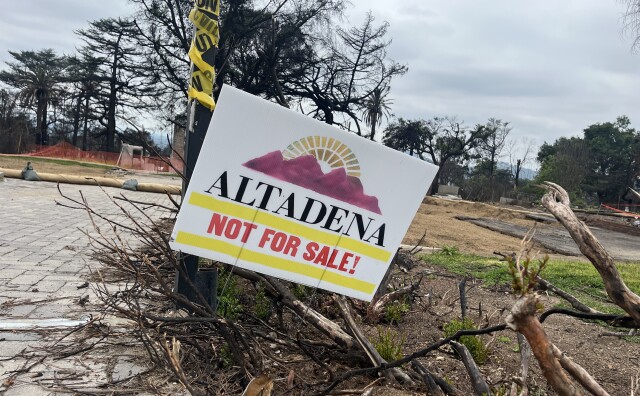Congress has cut federal funding for public media — a $3.4 million loss for LAist. We count on readers like you to protect our nonprofit newsroom. Become a monthly member and sustain local journalism.
This archival content was written, edited, and published prior to LAist's acquisition by its current owner, Southern California Public Radio ("SCPR"). Content, such as language choice and subject matter, in archival articles therefore may not align with SCPR's current editorial standards. To learn more about those standards and why we make this distinction, please click here.
Tips for Safe Hiking During Fire Season

By David Lockeretz of Nobody Hikes in LA / Special to LAist
Fall is fire season in southern California. People who are thinking of getting out into nature for a hike may be intimidated by dramatic reports of devastating wildfires on television and online, and obviously, a healthy respect for fear can be a life-saver. That being said, there are several easy precautions that can make exploring the outdoors in SoCal safe and enjoyable, even during fire season. Besides the obvious — not hiking in any areas where fires are burning — here are five safety tips to keep in mind.
Let someone know where you're going. This is a good thing to do regardless of what time of year you are hiking. In the film "127 Hours", based on Aron Ralston's ordeal in a remote Utah canyon, much is made of the fact that he didn't let anyone know where he was going.
Pack extra water. The fall is a dry time of year. Because temperatures are cooler than in the summer, it may not seem as if you need as much water, but hydration doesn't just make you feel good; it helps you avoid muscle cramps. If an emergency happens while you're hiking, you can last longer without food than without water.
When in doubt, stay coastal. To be sure, Laguna Canyon, the Santa Monica Mountains and other coastal areas of So Cal have had their share of wildfires, but they tend to be easier to contain than those higher up in the mountains, such as the Station Fire of 2009 or the Esperanza Fire of 2003. Coastal areas tend to be more populated than those at higher elevation, so resources are more accessible to fire fighters.
Knowledge is power. Most national and regional recreation areas in Southern California have web sites with detailed information about current conditions, including fire danger. Often times at trailheads and on roads leading to forests, signs will indicate current fire conditions. Although a sign indicating a "high" or even "extreme" fire danger doesn't automatically rule out an area for hiking, it is certainly something to consider.
Keep it short and sweet. While the L.A. basin is ringed by some dramatic mountain ranges, and while peaks such as Mt. Baldy, San Gorgonio and San Jacinto may be must-dos for many hikers, there are also hundreds of shorter trips that are very scenic and enjoyable. If you're worried about fires, save the 10-mile plus epics for the spring or summer and find a nice shorter trail that will get you out into nature.
While wildfires are a reality that must be dealt with and respected, with planning and a few
extra precautions, they don't have to prevent you from enjoying the huge variety of nature to be enjoyed in the Los Angeles area.
As Editor-in-Chief of our newsroom, I’m extremely proud of the work our top-notch journalists are doing here at LAist. We’re doing more hard-hitting watchdog journalism than ever before — powerful reporting on the economy, elections, climate and the homelessness crisis that is making a difference in your lives. At the same time, it’s never been more difficult to maintain a paywall-free, independent news source that informs, inspires, and engages everyone.
Simply put, we cannot do this essential work without your help. Federal funding for public media has been clawed back by Congress and that means LAist has lost $3.4 million in federal funding over the next two years. So we’re asking for your help. LAist has been there for you and we’re asking you to be here for us.
We rely on donations from readers like you to stay independent, which keeps our nonprofit newsroom strong and accountable to you.
No matter where you stand on the political spectrum, press freedom is at the core of keeping our nation free and fair. And as the landscape of free press changes, LAist will remain a voice you know and trust, but the amount of reader support we receive will help determine how strong of a newsroom we are going forward to cover the important news from our community.
Please take action today to support your trusted source for local news with a donation that makes sense for your budget.
Thank you for your generous support and believing in independent news.

-
People moving to Los Angeles are regularly baffled by the region’s refrigerator-less apartments. They’ll soon be a thing of the past.
-
Experts say students shouldn't readily forgo federal aid. But a California-only program may be a good alternative in some cases.
-
The program is for customers in communities that may not be able to afford turf removal or water-saving upgrades.
-
More than half of sales through September have been to corporate developers. Grassroots community efforts continue to work to combat the trend.
-
The bill would increase penalties for metal recyclers who possess or purchase metal used in public infrastructure.
-
The new ordinance applies to certain grocers operating in the city and has led to some self-checkout lanes to shutter.







